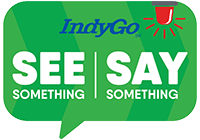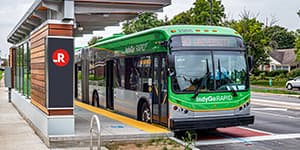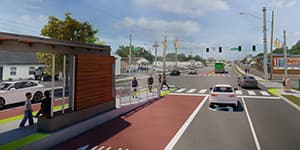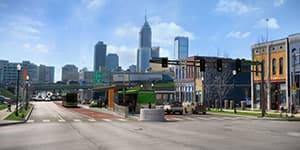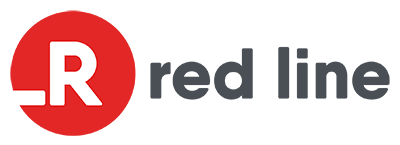New fare system and app coming soon, Red Line on schedule for Sept.1 opening
INDIANAPOLIS – Indianapolis is less than two months away from opening the nation’s first battery-electric bus rapid transit (BRT) system. At the June Board of Directors meeting, IndyGo announced this and several other updates on several major organizational initiatives. With construction progressing as planned and a successful expansion of bus operators, the transformative Red Line remains on-schedule for a September 1 opening.
Selected as the area’s first rapid transit route because of its ability to have the largest short-term impact while providing support for the rest of the system, the Red Line will be followed by construction of the two additional rapid transit lines, Purple starting in 2021 and Blue in 2023.
IndyGo’s Red, Purple and Blue lines will provide a network of reliable, modern, high capacity rapid transit service for Indianapolis and central Indiana,” said IndyGo President and CEO Mike Terry. “Research shows that reliable public transit encourages employers to locate near routes and gives employees the ability to get to and from work without a car. This is about economic mobility and needed infrastructure to support a world-class city.”
Red Line Construction
Since Red Line construction began in 2018, crews have been working daily – aboveground and below – to deliver the project on time. In addition to installation of more than 30 rapid transit stations thus far, construction has included improvements to sidewalks, curbs, storm sewer infrastructure and hundreds of ADA curb ramps.
As of June 27, 2019, crews had already completed:
- 28 miles of resurfaced roadway
- 50,203 linear feet of curb replaced
- 30,570 linear of sidewalk replaced
- 25,983 linear feet of storm sewer installed
- 530 ADA curb ramps
- 34 station platforms constructed
All stations will include ticket vending machines, real-time arrival information, seating, shelter, cameras and emergency call boxes. All BRT vehicles are battery-electric and are equipped with five doors and free WiFi.
“Rider experience is very important to us,” said IndyGo Vice President of Public Affairs Bryan Luellen. “Beyond the ability to stay connected digitally, riders want accessibility and efficiency. Each BRT bus has multiple doors, and with ticket purchases done at the stations, boarding the bus will take just a few seconds. The platforms are raised as well, making it easy to ride the bus in a wheelchair or with a bicycle or stroller.”
In conjunction with the opening of the Red Line, local route improvements will include extended evening hours, weekend frequency enhancements, and every route running every day. Additional local improvements will phase in through June 2020.
Operator Recruitment & Training
With the new Red Line and expanded services planned for the current system, IndyGo is undertaking considerable efforts to attract and retain operators. Efforts to date have included radio advertisements, social media, community events, job fairs, and weekly position vacancy updates to community, faith-based and social service organizations.
The organization reported these efforts as highly successful, with current employee totals at 95% of goal, which allows for planned service improvements to be implemented as scheduled.
IndyGo credited, in part, the organization’s offer to pay for employees to obtain their commercial driver’s license (CDL). All new hires without a CDL have a week of training to prepare for the state exam. Employees then have approximately 8-9 weeks of IndyGo’s Operator Training, which offers instruction both in the classroom and on the road.
To prepare for the Red Line opening, IndyGo has dedicated additional time and resources to conduct extensive training for all drivers, road supervisors, and dispatchers staff this June, July and August. During the next 5 years, IndyGo will continue to invest in service, which means even more local jobs well after the Red Line opens.
MyKey Fare System & App
Also this summer, IndyGo will launch MyKey, a new account-based fare system developed to provide a faster way to pay and ride. MyKey is a comprehensive, modern fare payment platform with many options including ticket vending machines, a mobile app and website. Customers will be able to load their accounts through IndyGo’s call center, at the Julia M. Carson Transit Center, ticket vending machines, online, through the MyKey mobile app, and at more than 400 retail locations across Marion County.
“Customers who move to the MyKey system instead of paper passes will access a new fare structure: daily and weekly fare-capping,” said President and CEO Mike Terry. “This means that riders only pay for the trips they take, and you don’t have to decide what type of pass you need. MyKey automatically gives you the best deal.”
Pilot testing will begin in July and the mobile application is anticipated to be ready for public download in August. Riders will have plenty of time to adjust as IndyGo is making its full system free to anyone during the entire month of September.
Purple & Blue Line Construction
The Purple and Blue Lines are major components of the Marion County Transit Plan. Like the Red Line, both lines will use battery-electric vehicles only, with stations featuring shelters, seating, ticket vending machines, real-time arrival information and WiFi.
Initial estimates for construction timing have varied, but IndyGo now anticipates the Purple Line – which replaces the existing Route 39 and connects downtown Indianapolis to the City of Lawrence – will bid in 2020 and begin construction in 2021. The Purple Line will run north on Meridian Street, head east on 38th Street and then north on Post Road. Prominent stops include the Transit Center, Indiana World War Memorial, The Children’s Museum of Indianapolis, Indiana State Fairgrounds, Fort Harrison State Park and two Ivy Tech Community College campuses.
The Blue Line – which will replace the existing Route 8 and run along Washington Street west to Indianapolis International Airport – will likely bid in 2022 and begin construction in 2023. The Blue Line will decrease current bus travel time between downtown and the airport by almost 13 minutes. IndyGo estimates two years for construction completion, with prominent stops at the Transit Center, airport, Indianapolis Zoo, Indiana State House, Irvington, Washington Square Mall and the campuses planned for Infosys and FedEx.
“We have an ambitious vision for a world-class transit network, and we are keeping projects moving,” said Bryan Luellen, vice president of public affairs. “There are a number of factors that influence timelines for projects of this size. IndyGo is adjusting its Capital Plan timelines for Blue and Purple Lines to acquire needed property, coordinate with DPW and utilities, and to finalize federal grants. This is the very beginning of a years-long investment in transit service and enhancements.”
“With our Purple Line construction schedule and the recent announcement that the North Split and Interstate 69 will be happening in 2021 and 2022, we see a need to revise the Blue Line timeline and relieve pressure on commuters and the available contractors,” said Justin Stuehrenberg, vice president of planning and capital projects. “IndyGo will continue working with the City of Indianapolis Department of Public Works on the Purple Line, while also focusing on our transit service, mobility integrations, and technologies that will keep IndyGo moving forward.”
###
About IndyGo
IndyGo, the Indianapolis Public Transportation Corporation, is committed to connecting the community to economic and cultural opportunities through safe, reliable, and accessible mobility experiences. IndyGo’s Marion County Transit Plan will bring a 70% increase in IndyGo services with extended hours and shorter wait times starting this year. To learn more, visit our website, follow us on Twitter @IndyGoBus, or call 317.635.3344.
